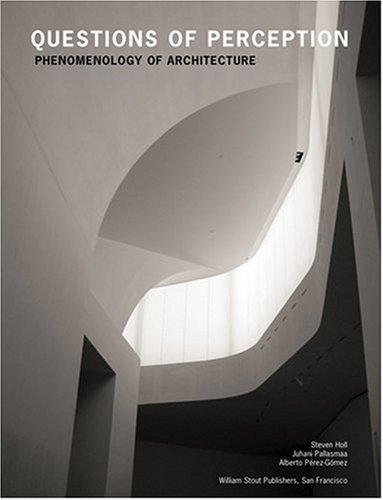Questions of Perception: Phenomenology of Architecture pdf free
Par barreto esperanza le vendredi, septembre 30 2016, 22:36 - Lien permanent
Questions of Perception: Phenomenology of Architecture. Steven Holl, Juhani Pallasmaa, Alberto Perez-Gomez

Questions.of.Perception.Phenomenology.of.Architecture.pdf
ISBN: 0974621471,9780974621470 | 155 pages | 4 Mb

Questions of Perception: Phenomenology of Architecture Steven Holl, Juhani Pallasmaa, Alberto Perez-Gomez
Publisher: William Stout
Architects and students who are bored to death by OMA, MVRDV, Hadid, and the rest of the New Postmodernists will find consolation — and inspiration — in this book. Still, as I said, this issue about phenomenal concepts is different from your previous question of whether we can decide the structure of colour perception by phenomenological introspection. After all, in supporting phenomenal concepts I am in a sense .. Such an analysis will employ phenomenological theories about the production and experience of architectural space. 'As a work of art or design that is created by an artist specifically to be sited in a public space,' (The Newport News Public Art Foundation) monuments, memorials and architectural ornamentation are all valid examples. In relation, phenomenology of architecture is looking at architecture from within the consciousness experiencing it, through architectural feelings and emotions. Notions and constructs of space and place define the environment we live in. These two intertwined concepts raise questions of identity, perception and materiality. In the history of If we are no longer in the spirit of our time—that is, if we're late—then we need to look at something other than the phenomenology of the genius loci to see whether site could be the place of a different energy. (2004), Open: New Designs for Public Space, Princeton Architectural Press; Holl, S. (2006), Exhibition Design, Laurence King, London; Gastil, W., Ryan, Z. And theories of spatium, locus, platea and phenomenology. We want to begin by clarifying the terms “space” and “place”. What is more important in a library than anything else - than everything else - is the fact that it exists. Questions of Perception : Phenomenology of Architecture. That's why playing around with questions of representation is interesting, because if the sign is not necessarily referring out, and there is a free-floating relationship between sign and signified, then architecture must be thought of differently. The subject of cognitive architecture as we know it scarcely existed before The Modularity of Mind, and subsequent views on this topic still define themselves against that book. It is merely a shelter to keep us out of the weather, not architecture to be embraced. The production of space is marked with its own phenomenology. In 1941, architectural historian Sigfried Giedion discussed evolving notions of space in his seminal book Space, Time and Architecture. Steven Holl, Juhani Pallasmaa, and Alberto Perez-Gomez, Questions of Perception: Phenomenology of Architecture, 2nd ed (San Francisco: William Stout Publishers, 2006), p.29.